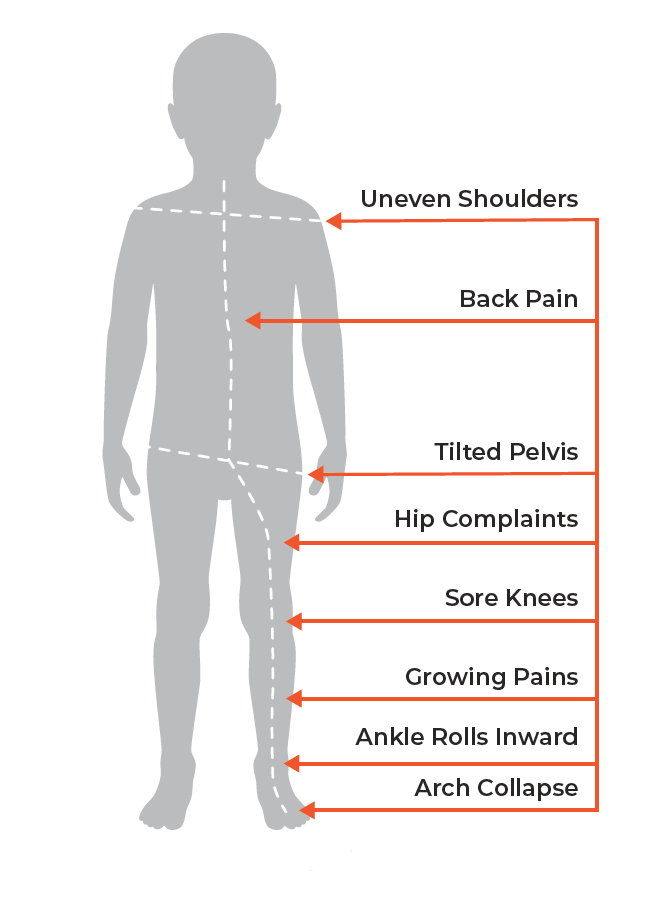Most children are born with what may be considered underdeveloped arches in their foot; this is in reality a ‘fat’ foot. It’s simply due to the normal fat distribution at the bottom of the foot. At this age, bones and joints are flexible. Generally, the arch is expected to naturally develop by age 3 or 4. In cases of genetically occurring flat feet in children, there is an improper bone structure, the arch will not develop properly and could cause longer term issues.
How do I know if my child has misaligned feet?
Some children may not be able to verbalize the symptoms they are experiencing, but parents can still spot signs of a problem. Check to see if your child exhibits any of the
following behaviors.
- Child wants to be held and carried longer/more often than other children, especially when walking.
- Child avoids/resists normal physical activities, runs significantly slower and/or is less coordinated than other children.
- Child’s shoelaces come untied more than normal due to the foot rolling inward at the ankle.
- Child experiences growing pains at bedtime and/or wakes up shortly after falling asleep from pain in their legs.
- Child is unusually overweight, typically due to a lack in activity level.
- Child has collapsed arches or “too many toes syndrome”.

What do misaligned feet look like?

A flat foot or “fallen arch” is not the only symptom. Feet may roll in – called “over- pronation” or “hyper-pronation.”

The Symptoms
These may be signs of a serious, yet easily treatable condition. While some of these symptoms may appear to go away on their own, the underlying cause still exists. Over time, the symptoms resurface, manifesting as different, more severe, medical conditions. The basis of these progressive problems cannot be outgrown or effectively treated with exercise or physical therapy. They are part of an anatomical, internal problem.
The Problem
Many musculoskeletal problems are caused or made worse by misaligned feet. This misalignment is the result of a common condition called talotarsal displacement. Talotarsal displacement occurs when the ankle bone slides off the heel bone. When this happens, the ankle rolls inward and causes the front of the foot to turn outward. When talotarsal displacement is left untreated, it forces the body to compensate by putting excessive strain on the heels, ankles, knees, hips and back. This causes a variety of additional symptoms, which can eventually lead to other secondary health conditions.

Misaligned feet are NOT a good thing – even if your child doesn’t have low or flat arches.
The Solution
HyProCure® is a titanium stent that is placed into a naturally occurring space between the ankle and heel bones through a small incision below the outer ankle bone. Once the stent is placed, it realigns the foot and restores the natural joint motion.
FDA cleared since 2004, HyProCure® is an evidence-based procedure that has been used by foot & ankle surgeons globally in tens of thousands of pediatric and adult patients of all activity levels. HyProCure® is centrally placed into a naturally occurring space in between the ankle and heel bones allowing for natural movement. Other similar devices are designed to block the joint which restricts natural movement. Since HyProCure® is made of titanium, it won’t set off metal-detectors and recipients can still undergo MRI or CT scans. Most patients are able to walk again within a few days after the procedure is performed. (Note that this depends on whether the HyProCure® procedure is the only one performed). Minimal pressure is placed on the stent itself. Once HyProCure® is placed, the bones will realign and the majority of the body’s weight will be rebalanced on the bones surrounding it. Though cause for removal is rare (6% vs. over 40% in other devices), the procedure is reversible.


